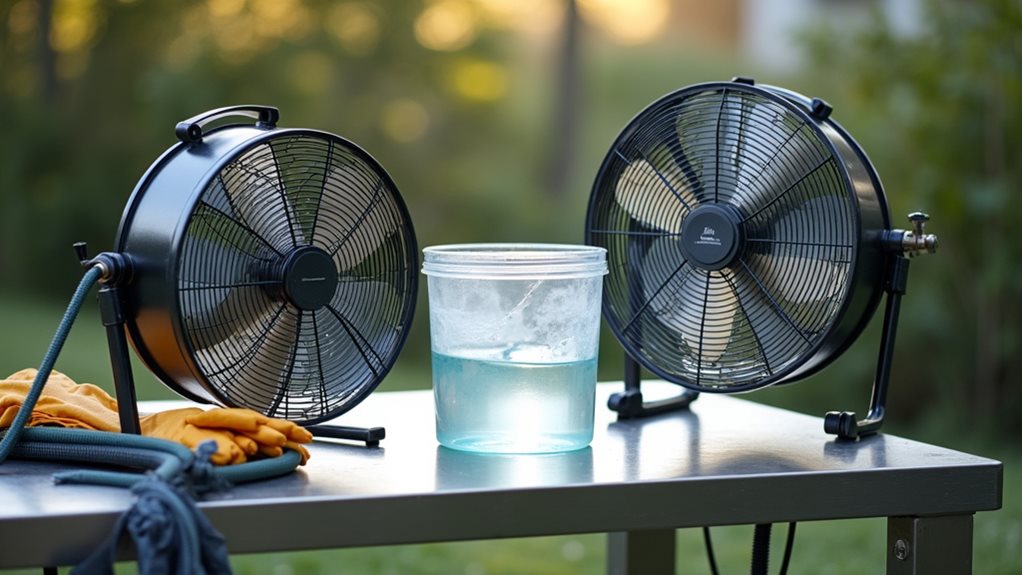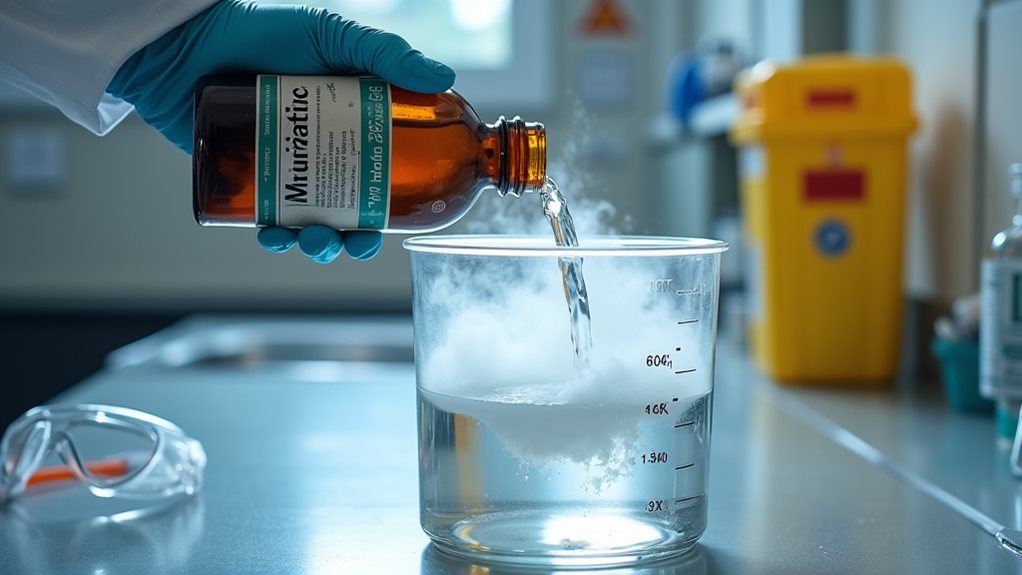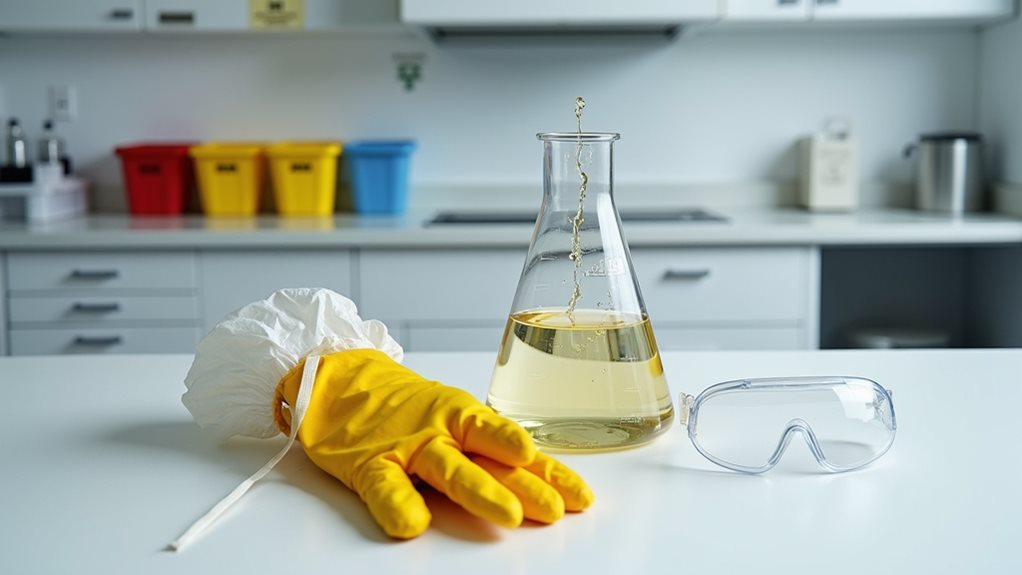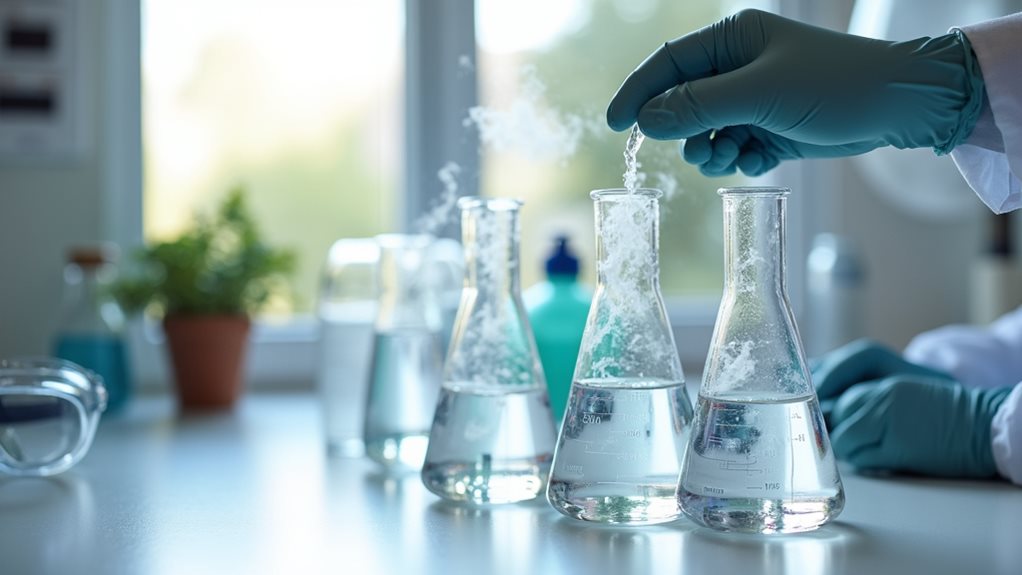To safely dilute muriatic acid, you’ll need proper protective gear including chemical-resistant clothing, goggles, gloves, and a respirator. Always work in a well-ventilated area and follow the 1:10 ratio rule – slowly add acid to water, never water to acid. Use plastic or glass containers for mixing, and keep safety equipment and water source nearby in case of emergency. Understanding proper handling techniques is essential for working with this powerful chemical.
TLDR
- Always wear complete protective gear including chemical-resistant clothing, goggles, gloves, boots, and a dual-cartridge respirator before handling acid.
- Work in a well-ventilated area or outdoors, keeping safety equipment and water source nearby for emergency response.
- Pour acid slowly into water using a 1:10 ratio (never water into acid), stirring continuously to ensure proper mixing.
- Use only plastic or glass containers for mixing to prevent chemical reactions, and verify calculations before starting dilution.
- Keep first aid supplies ready and know emergency protocols, including flushing with water for skin contact or eye exposure.
Essential Safety Equipment and Protective Gear

When working with muriatic acid, you’ll need to prioritize your safety by using thorough protective equipment and gear designed specifically for handling corrosive chemicals.
You’ll require chemical-resistant clothing made from PVC or Butyl rubber, dual-cartridge respirators for fume protection, and safety goggles with side shields. Understanding the importance of proper fitting for equipment can help ensure maximum safety while handling hazardous materials.
Don’t forget chemical-resistant gloves and boots, and make certain you’re working in a well-ventilated area. An additional layer of protection can be achieved by wearing a chemical resistant apron while handling the acid.
Understanding Dilution Ratios and Measurements
Now that you’re properly equipped with safety gear, you’ll need to become proficient in the precise measurements and ratios required for diluting muriatic acid.
The most common dilution ratio is 1:10 (one part acid to ten parts water), though you might use a 1:16 ratio for lighter tasks. Effective prevention strategies can help keep your workspace clear of potential hazards.
Always add the acid to water slowly, and use plastic or glass containers for mixing to prevent unwanted reactions. Professional cleaning tasks will require full protective equipment as muriatic acid can cause burns to skin, making proper handling essential.
Proper Workspace Setup and Ventilation

A proper workspace setup serves as your first line of defense when handling muriatic acid safely.
You’ll need to work outdoors or in a well-ventilated area, with all safety equipment readily accessible.
Set up your workspace away from other chemicals, protect the floor with drop cloths, and make sure you’ve got a water source nearby for emergency washing.
Don’t forget to install proper ventilation if working indoors. Additionally, consider using soundproofing materials to minimize noise that may distract you while working.
Step-by-Step Dilution Process
Following proper safety procedures forms the foundation of any successful acid dilution process.
You’ll need to carefully add the concentrated acid to water using a calibrated pipette, never the reverse.
While stirring continuously, maintain a 1:10 ratio for pool applications, or use 1.5 mL per gallon for vinegar-strength solutions.
Always verify your calculations before proceeding with the dilution. Additionally, ensure you wear disposable latex gloves to protect your hands from any potential splashes during the process.
Emergency Response and First Aid Protocols

When dealing with muriatic acid, understanding proper emergency response and first aid protocols can mean the difference between minor incidents and serious injuries.
If exposure occurs, don’t induce vomiting for ingestion; instead, drink water or milk.
For skin contact, remove contaminated clothing and rinse thoroughly.
If inhaled, move to fresh air immediately, and for eye exposure, flush with water for 15-20 minutes.
Storage and Handling Best Practices
Proper storage and handling practices serve as critical safeguards when working with muriatic acid’s corrosive properties.
You’ll need to store the acid in its original container, kept in a cool, well-ventilated area away from sunlight and other chemicals.
When handling, always use designated tools, wear appropriate PPE, and inspect containers regularly for damage.
Don’t forget to maintain detailed records of your storage procedures.
Proper Disposal Methods and Environmental Considerations

Before disposing of muriatic acid, you’ll need to check your local regulations, as requirements vary by jurisdiction and many areas prohibit direct drain disposal.
You must neutralize the acid with baking soda or garden lime until it reaches a pH of 7, testing with pH strips to confirm complete neutralization.
Once neutralized, you can transport the solution to a hazardous waste facility or, if permitted by local ordinances, dilute it substantially with water before carefully pouring it down an approved drain system, making sure to never use storm drains where the chemicals could harm the environment.
Legal Disposal Requirements
Since muriatic acid is classified as hazardous waste under RCRA guidelines, you’ll need to follow strict federal, state, and local regulations for its disposal.
Never dispose of the acid down drains or in regular trash, as this poses severe environmental risks.
Instead, you must transport it to authorized hazardous waste facilities in sealed containers, where they’ll properly handle its disposal according to legal requirements.
Chemical Neutralization Steps
When handling hazardous materials like muriatic acid, neutralization provides a safe and effective method for disposal that complements legal requirements.
Add bases like baking soda or lime gradually to the acid in a well-ventilated area while wearing protective gear.
Monitor the temperature carefully, as these reactions generate heat, and dispose of the neutralized solution according to local regulations.
Environmental Impact Prevention
Proper disposal of muriatic acid requires careful attention to environmental impact prevention and regulatory compliance.
You’ll need to dilute the acid with water before disposal and make certain it’s taken to designated hazardous waste facilities.
Always store the acid in its original container, implement spill control measures, and follow local regulations to prevent water pollution and soil degradation that can harm ecosystems.
Common Applications and Usage Guidelines

Muriatic acid’s versatility makes it an indispensable chemical for both industrial and household applications.
You’ll find it’s particularly effective for cleaning concrete surfaces, maintaining pool pH levels, and removing rust from metal surfaces.
When using it for household tasks like toilet cleaning or mineral deposit removal, you’ll need to follow proper dilution ratios and always wear appropriate protective equipment.
Final Note
You’ve now learned the essential protocols for safely diluting muriatic acid, from proper protective equipment to correct disposal methods. Remember, you’ll need to consistently follow safety guidelines to protect yourself and others when handling this powerful chemical. While muriatic acid is a significant tool for many applications, it’s vital that you respect its potential dangers and always maintain proper dilution ratios. When in doubt, consult a professional or chemical safety specialist.